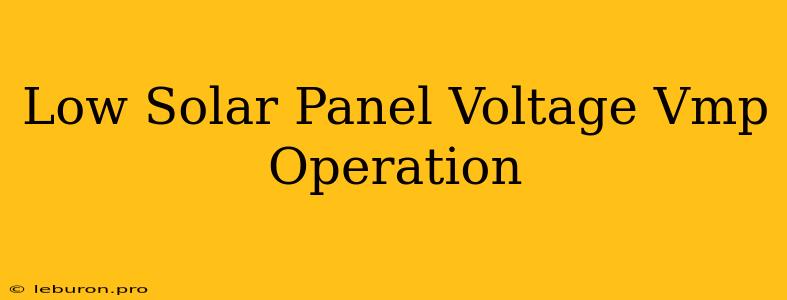The efficiency and performance of a solar panel are significantly impacted by its operating voltage, particularly the maximum power voltage (Vmp). This voltage represents the point at which the panel generates the most power. While solar panels are designed to operate within a specific voltage range, understanding the factors that can influence low solar panel voltage Vmp operation is crucial for maximizing energy production and ensuring optimal system performance. This article will delve into the complexities of low solar panel voltage Vmp operation, exploring the underlying causes, implications, and potential solutions.
Understanding Vmp and its Significance
The Vmp is a key characteristic of a solar panel and represents the voltage at which the panel produces the maximum power output. This value is usually specified in the panel's datasheet. When a solar panel operates at its Vmp, it is efficiently converting sunlight into electricity. However, various factors can lead to low solar panel voltage Vmp operation, ultimately impacting the panel's overall power output.
Causes of Low Solar Panel Voltage Vmp Operation
Several factors can contribute to low solar panel voltage Vmp operation, including:
-
Environmental Factors:
- Temperature: Solar panels are sensitive to temperature variations. As the temperature increases, the Vmp typically decreases. This is because the silicon material in the solar cells loses efficiency at higher temperatures.
- Shading: Even partial shading can significantly reduce the Vmp of a solar panel. This is because shading creates a current mismatch within the panel, leading to a reduction in overall power output.
- Irradiance: The amount of sunlight hitting the panel, known as irradiance, directly impacts the Vmp. Lower irradiance levels, such as during cloudy days or early morning/late evening hours, will result in a lower Vmp.
-
Panel Degradation: Over time, solar panels can degrade, leading to a gradual decrease in their Vmp. This degradation is primarily caused by factors like:
- Contamination: Dust, dirt, bird droppings, and other contaminants on the panel's surface can block sunlight and reduce efficiency, ultimately impacting the Vmp.
- Cell Damage: Physical damage to the solar cells, such as scratches, cracks, or hotspots, can also cause a reduction in the Vmp.
-
System Issues:
- Mismatched Panels: In a system with multiple panels, mismatched panel ratings can cause low solar panel voltage Vmp operation. This mismatch occurs when panels have different Vmp values, leading to inefficiencies within the system.
- Wiring Issues: Faulty wiring, loose connections, or corroded terminals can hinder current flow and negatively impact the Vmp.
- Inverter Problems: A malfunctioning inverter can also cause low solar panel voltage Vmp operation by not properly converting the direct current (DC) produced by the panels into usable alternating current (AC).
Implications of Low Solar Panel Voltage Vmp Operation
Low Vmp operation has several significant implications for solar panel performance and system efficiency:
- Reduced Power Output: The most direct consequence of low solar panel voltage Vmp operation is a reduction in power output. This means less electricity is generated, impacting the overall energy production of the solar system.
- Increased System Costs: The reduced power output can necessitate the use of more solar panels to achieve the desired energy output. This can lead to increased installation costs and potentially higher ongoing maintenance expenses.
- Shorter Panel Lifespan: While not a direct result of low Vmp, prolonged operation at a lower voltage can potentially accelerate panel degradation, ultimately shortening the lifespan of the solar panel.
Troubleshooting Low Solar Panel Voltage Vmp Operation
Addressing low solar panel voltage Vmp operation requires a systematic approach involving several steps:
- Inspection and Monitoring: Begin by visually inspecting the solar panels for any visible signs of damage, dirt, or shading. Use a multimeter to measure the Vmp of individual panels and compare the readings to the manufacturer's specifications.
- Environmental Factors: Consider the prevailing weather conditions, temperature, and irradiance levels. Assess if these factors could be contributing to the low Vmp readings.
- System Components: Check for any faulty wiring, loose connections, or signs of corrosion in the system's wiring. Inspect the inverter for any operational issues.
- Professional Assessment: If the issue persists, consider consulting a qualified solar technician to perform a comprehensive system diagnosis. They can identify any underlying problems and recommend appropriate solutions.
Solutions for Low Solar Panel Voltage Vmp Operation
Depending on the cause of low solar panel voltage Vmp operation, various solutions can be implemented to restore optimal performance:
- Cleaning: Regularly cleaning the solar panels to remove dirt, dust, and other debris can significantly improve efficiency and restore the Vmp to its optimal levels.
- Shading Mitigation: Address any shading issues by trimming trees or installing shading mitigation devices.
- Panel Replacement: If a panel shows signs of damage or significant degradation, replacing it with a new panel can improve overall system performance and restore the Vmp.
- System Optimization: If the low Vmp is caused by mismatched panels or wiring issues, system optimization can be necessary. This may involve adding a power optimizer to each panel or rewiring the system to ensure efficient current flow.
- Inverter Replacement: If the inverter is malfunctioning, replacing it with a new and compatible model can resolve the issue and restore the Vmp to its optimal level.
Conclusion
Maintaining optimal Vmp is crucial for maximizing the efficiency and performance of your solar system. By understanding the potential causes of low solar panel voltage Vmp operation, you can proactively troubleshoot and address any issues that arise. Regular inspection, cleaning, and professional maintenance play vital roles in preventing low Vmp and ensuring the long-term performance of your solar investment.
